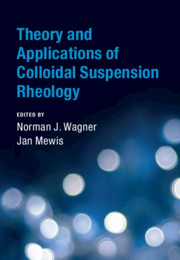Book contents
- Theory and Applications of Colloidal Suspension Rheology
- Cambridge Series in Chemical Engineering
- Theory and Applications of Colloidal Suspension Rheology
- Copyright page
- Dedication
- Contents
- Contributors
- Preface
- General List of Symbols
- Useful Physical Constants and Values
- 1 Introduction to Colloidal Suspension Rheology
- 2 Theory of Colloidal Suspension Structure, Dynamics, and Rheology
- 3 Methods of Colloidal Simulation
- 4 Microstructure under Flow
- 5 Rheology of Colloidal Glasses and Gels
- 6 Suspensions of Soft Colloidal Particles
- 7 Biocolloid Rheology
- 8 Hemorheology
- 9 Applications
- Index
- References
6 - Suspensions of Soft Colloidal Particles
Published online by Cambridge University Press: 07 April 2021
- Theory and Applications of Colloidal Suspension Rheology
- Cambridge Series in Chemical Engineering
- Theory and Applications of Colloidal Suspension Rheology
- Copyright page
- Dedication
- Contents
- Contributors
- Preface
- General List of Symbols
- Useful Physical Constants and Values
- 1 Introduction to Colloidal Suspension Rheology
- 2 Theory of Colloidal Suspension Structure, Dynamics, and Rheology
- 3 Methods of Colloidal Simulation
- 4 Microstructure under Flow
- 5 Rheology of Colloidal Glasses and Gels
- 6 Suspensions of Soft Colloidal Particles
- 7 Biocolloid Rheology
- 8 Hemorheology
- 9 Applications
- Index
- References
Summary
Softness has a great impact on the properties of colloidal suspensions, especially at high concentrations. Particle deformability due to crowding is responsible for elastic interactions strongly affecting the dynamical properties, which therefore differ from those of hard spheres. The universal aspects of the linear and nonlinear rheological response, based on appropriate scaling, are discussed. Different approaches to determine an effective volume fraction and its role on the low frequency plateau modulus in the glassy and jamming regimes are presented. The flow properties often follow Herschel–Bulkley behavior, with the particle microstructure and interactions affecting the yield stress and causing shear banding or wall slip in some cases. Concentrated suspensions exhibit aging and internal stresses with several common but also distinct features compared to hard sphere glasses. The rich state diagrams of mixtures involving soft colloidal glasses and additives (linear polymers, soft or hard particles) suggest the possibility to tailor their flow properties, often in unprecedented ways, by means of osmotic interactions. This wealth of physical properties in relation to particle interactions can be described by different microstructural, statistical, and phenomenological models which offer a valuable predictive toolbox for understanding the complex and tunable rheology of this class of systems.
- Type
- Chapter
- Information
- Theory and Applications of Colloidal Suspension Rheology , pp. 227 - 290Publisher: Cambridge University PressPrint publication year: 2021
References
- 5
- Cited by

